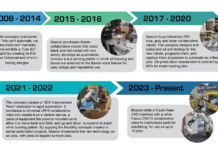By Brett Beardsley, president, Bear Industrial Group
 Whether injection molding, blow molding, thermoforming or rotomolding, equipment breakdowns are inevitable in a manufacturing facility – some with simple-fix solutions and some requiring extensive repairs or replacements. The decision of whether to repair or replace equipment can come down to the availability of skilled repair technicians, cost and downtime potential.
Whether injection molding, blow molding, thermoforming or rotomolding, equipment breakdowns are inevitable in a manufacturing facility – some with simple-fix solutions and some requiring extensive repairs or replacements. The decision of whether to repair or replace equipment can come down to the availability of skilled repair technicians, cost and downtime potential.
This Q&A provides insights into key decision factors that come into play when manufacturers decide to repair rather than replace their failing hydraulic, mechanical and electronic components.
What factors are involved in determining whether to repair vs. buy new?
In today’s manufacturing climate, cost typically is the main consideration. However, there are other factors that play a big part in an operation’s decision making.
Many of our customers use the “50% cost of new” guideline as their limit in deciding whether to repair, especially for lower cost items – although savings still can be realized on high-dollar equipment. Customers know their machines and know what the expensive items are, so when something can be repaired, it often makes more sense to avoid the capital expense of purchasing new.
Timing and availability are the two other key factors that play into “repair vs. replace” decision making. Oftentimes, manufacturing equipment gives no notice and suddenly breaks down, requiring maintenance to scramble for a repair solution if a spare isn’t readily available. Additionally, due to the age of some production machines, new replacement pumps, valves and motors can have very long lead-times or may be obsolete. In this instance, an engineered retrofit unit could get the customer quickly back up and running, saving weeks, if not months of costly lost production.
Regardless of the amount of wear or damage, all repairs should be rebuilt to OEM specifications and tested to ensure they perform to the design intended performance. Essentially, repairs should provide like-new performance at a fraction of the cost.
Are there steps customers can take to help or even prevent future failures?
Yes, absolutely. Equipment maintenance is much like car maintenance – regular oil changes and service calls can keep your car running smoothly and avoid those really expensive repairs brought on by neglect.
For instance, we often see issues with hydraulic pump, motor and valve failure attributed to oil condition and/or neglect – including clogged strainers and filters, filters in bypass and heavy varnish. A tremendous amount of work goes into evaluation, root cause analysis and performing the necessary work to properly repair these components. It’s important to address those underlying causes, because the last thing we would want is for customers to experience a repeat problem after re-installation of the equipment. We highly recommend customers utilize this downtime to perform cleanout measures prior to re-installation. This typically includes all inlets lines, strainers, reservoir, case drain lines and immediate discharge lines. Although these preventive measures are laborious, they significantly reduce the risk of start-up and repeat failures in the future.
Should molders use a repair partner or in-house staff?
Many molders have trained technicians on hand for minor repairs and daily production adjustments. When the needed repairs are extensive – or the trained technicians retire and aren’t easily replaced – a repair partner can provide an on-demand solution.
Also, replacement part inventory can play a role in this decision. If the breakdown involves a failing component, it can be cost prohibitive for a molder to stock an extensive inventory of spare parts. A repair partner can stock both spare parts and pre-built units to reduce the potential for extensive downtime.
Bear Industrial Group, Mount Clemens, Michigan, is a full-service hydraulic, mechanical and electronic repair facility serving hundreds of satisfied customers throughout the United States, Canada and Mexico. For over 25 years, Bear has built a commanding reputation for repairing many components found within the plastics molding industry, specializing in injection molding, blow molding, thermoforming, roto-molding and secondary equipment. Bear’s highly skilled in-house technicians can handle repairs of many different types and brands, resulting in reduced overall costs and downtime.
More information: www.bearig.com or call 888.345.BEAR




